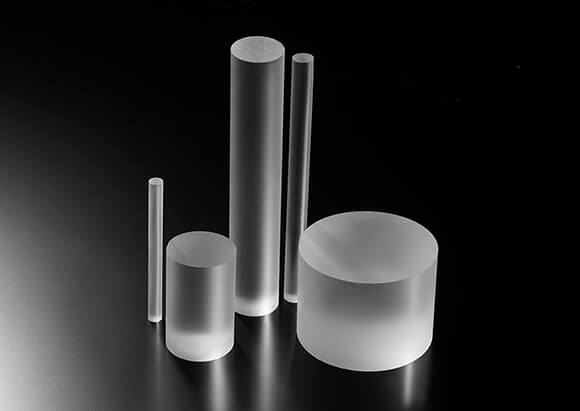
UV Calcium Fluoride
Typical spectral characteristics are 205NM and 306NM with no significant absorption, and the requirement for no reduction in infrared transmission. UV single crystals are mostly used in day-blind detectors 260-280NM or for UV imaging to eliminate chromatic aberrations, resulting in lower noise and better image quality. They are also partially used in UV vacuum observation windows or for spectral analysis. UV materials are mostly high purity chemical synthetics and require controlled absorption of cerium and lead in the crystal growth and must comply with ROHS & REACH standards. There are, of course, some natural ore materials that are screened later to meet the requirements, but because the consistency and stability of the material is not guaranteed, natural materials are generally not recommended.
Applications :
Uv monocrystals are mainly used in solar blind detector 260-280nm or ULTRAVIOLET imaging, and also partly used in ultraviolet vacuum observation window or spectral analysis. The application band of ultraviolet calcium fluoride is 130-200nm, sometimes up to 110NM. The material is mainly used in ultraviolet spectral analysis and detection and KF/CF vacuum window. The material is required to have high transmittance below 200NM and good irradiation resistance, and is mainly used in the window piece. Vacuum grade calcium fluoride requires high purity of raw materials, at the same time to control the mixing of other elements in the crystal growth process, and try to improve the transmittance below 200NM.
Product Advantage :
Achromatic effect, lower noise, better image quality.
Material size: monocrystalline up to 200MM; polycrystalline up to 350mm
Supply capacity: cycle time mostly 2-3 weeks, quantity 5-100 wafers
Processing capacity: 10-5; 1/10L
Forming capacity: flat, spherical, aspherical, prismatic, cylindrical, slotted, perforated
Product Parameters :
Do UV materials have to be polycrystalline?
Of course not, polycrystalline is the crystal structure and UV is the crystal band. So there are both polycrystalline and monocrystalline materials in this band of UV. The choice of material depends on the designer, or ask your ICC technical sales person.
Why is my UV CAF2 noisy?
UV solar blind detectors require no noise, but at 200-400NM they often require a coating with a typical R<0.5%.
The noise can be caused by a number of factors, possibly related to the material element, possibly related to the coating auxiliaries, and possibly due to a reaction between the material and the bonding of the film layer. The general recommendation is to test the uncoated lens to see if there is noise, and if not, to conclude that it is caused by the later coating. It is also advisable to have both the polishing and coating done by ICC to get the best solution.
What material is used for 300-700NM?
Obviously below 400NM is the UV band, so the material used is UV material.
How thick do I need my viewing window?
This is based on the size, thickness, hardness, and atmospheric pressure of the material, calculated by a specific formula, details can be consulted by ICC technical sales staff
What kind of material is needed for vacuum observation window?
It is recommended that single crystal oriented materials, such as no pressure requirements, polycrystal is also possible
Why did my vacuum window weld the crystal split?
There is a risk of cracking in welding, but the risk can be reduced as much as possible through mature technology, requiring that the thermal expansion coefficient of solder and crystal be as constant as possible, and the mechanical pressure be controlled as much as possible when sealing. If special requirements, it is generally recommended to do metallization first, and then in welding, so that the rate of finished products will be greatly improved, of course, the price is very expensive.
products and services.






